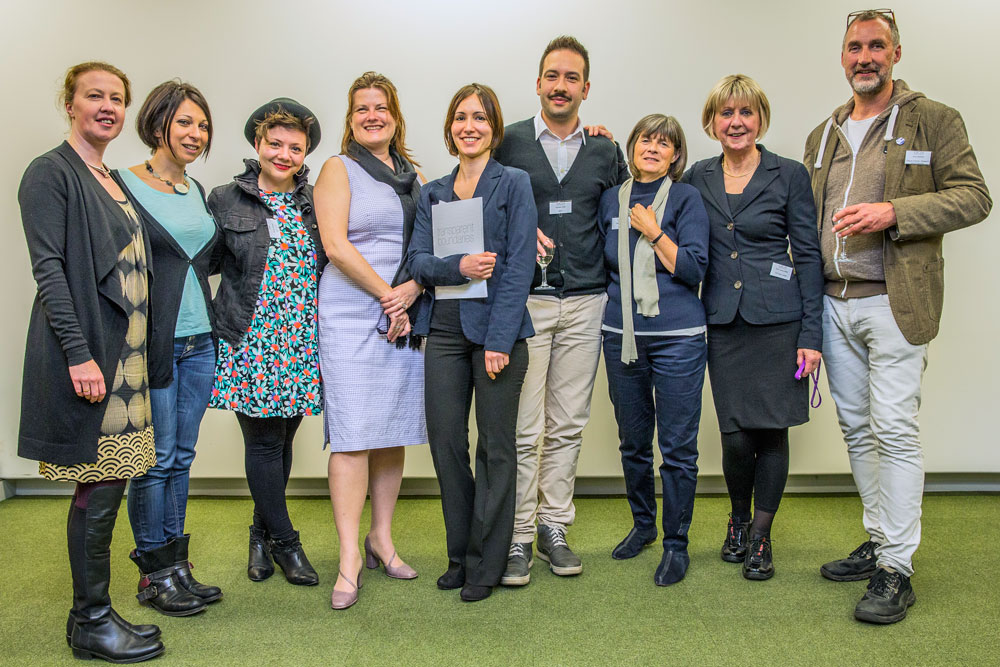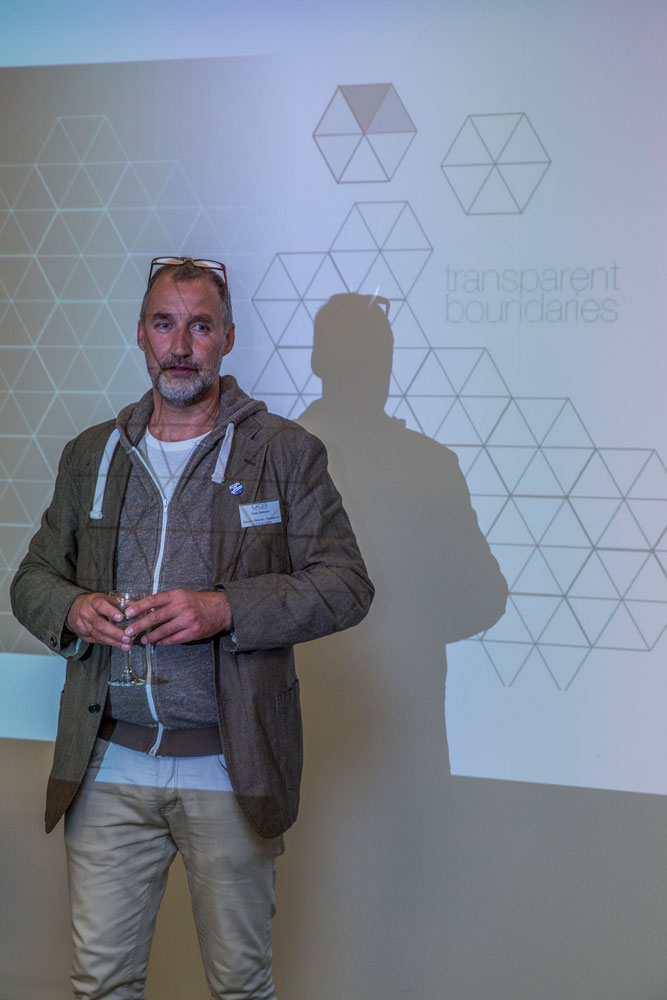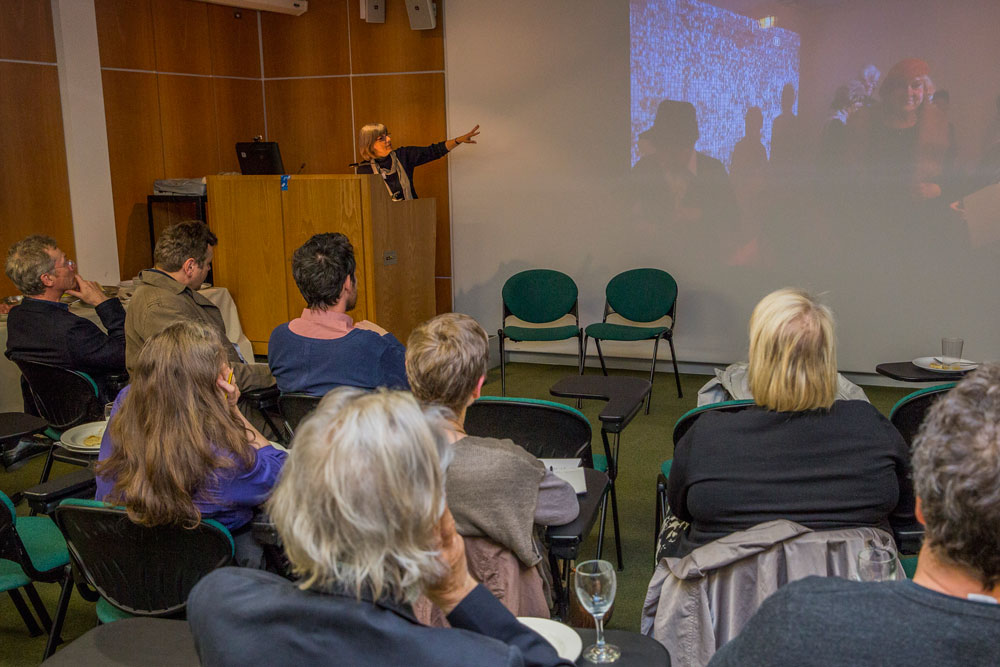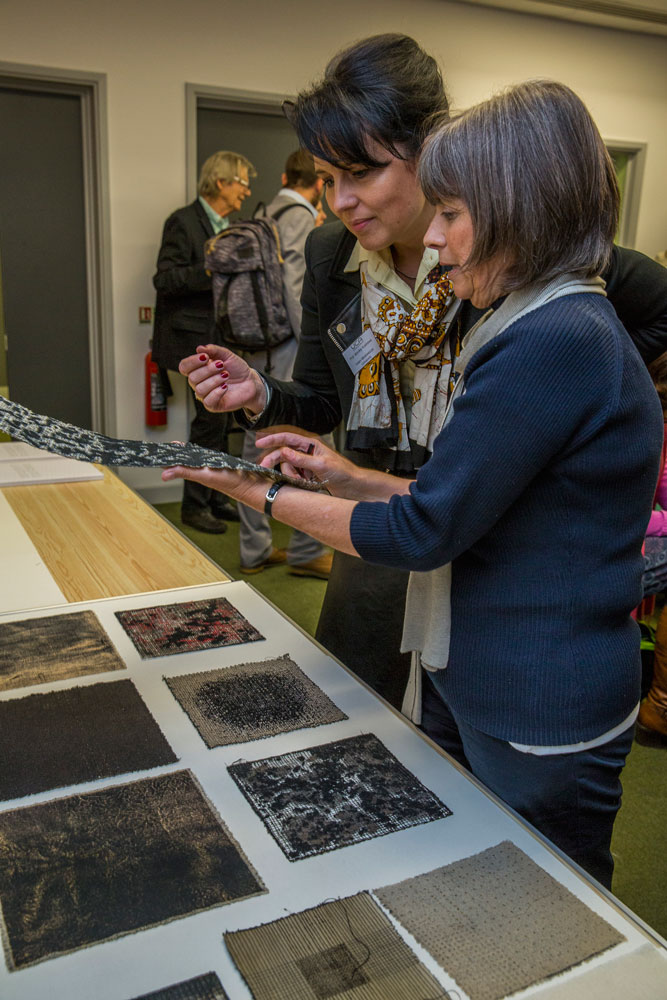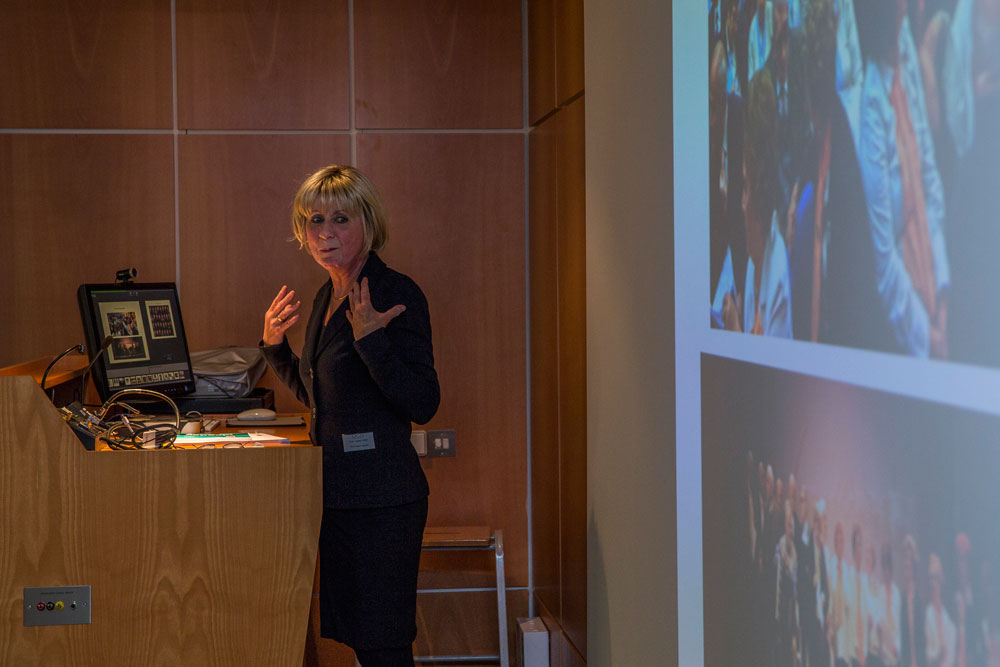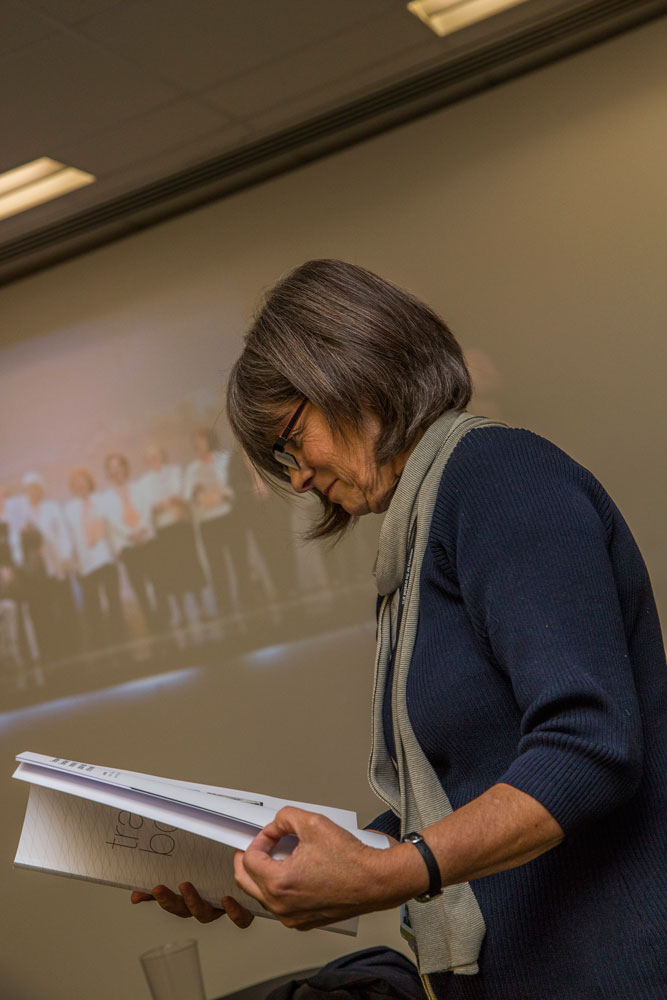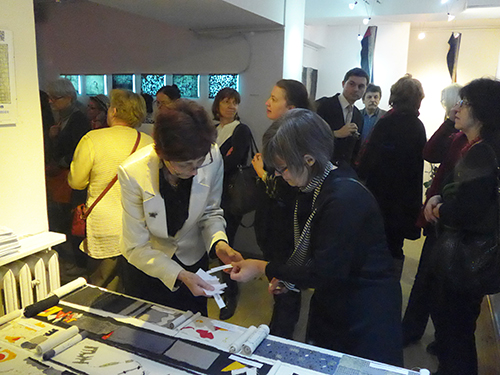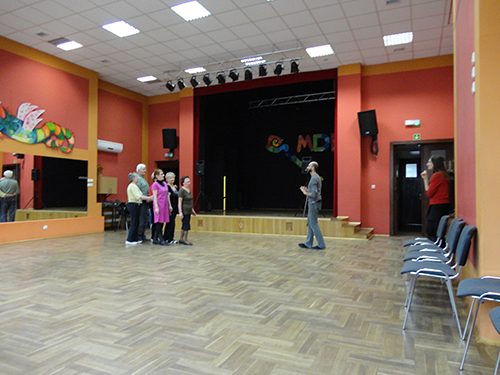I had the great good fortune to be invited by Marian Bijlenga to visit her at her studio in Amsterdam as preparation for a text she has asked me to write for a monograph chronicling her 30 years as an artist. Her studio was an oasis of calm in a baking hot, tourist filled Amsterdam and it was a great privilege to look closely at so many of her works from very early ones to the latest, and to discuss them with her. It was particularly interesting to see some of the 30 miniatures she has recently created to represent a work or series of works from those 30 years, each one a tiny and complete version of a larger work.
West Dean Tapestry Symposium 2015: skill-based making in the contemporary art world.
Next year I will be working with the National Centre for Craft and Design in Lincolnshire in the curation of an international tapestry exhibition due to open at the NCCD in October. This will be the first such major exhibition in England since 1994 and I am very excited to be involved. Therefore it was extremely timely to be invited to present a paper at the West Dean Tapestry Symposium and I was delighted to take part. There was an excellent turnout, with many of our most eminent tapestry artists in the audience. Anne Jackson and Shelly Goldsmith both spoke in depth about the ways in which their work has developed over the years whilst retaining its original research focus. There were also presentations from West Dean Studio weavers Katherine Swailes and Philip Sanderson described the balance between the Studio commissions and their own work. Other presentations were by Yvonna Demczynska who spoke about the promotion and selling of textiles in her Gallery Flow; and by Dr Liz Clay who described the progress and outcome of her collaboration as a felt artist with two Aubusson tapestry weavers. I wound up the day by reminding us of our recent history and discussing ways in which tapestry weaving can reflect contemporary social and political ideas. The event was followed by a viewing of the exhibition 'Hellreaf'.
Transparent Boundaries nominated for a THELMA
I am absolutely delighted that the EU Transparent Boundaries project has been nominated for the Times Higher Education Leadership and Management Award 2015 most innovative and original initiative in knowledge exchange. For Higher Education in the UK this is an equivalent to an Oscar nomination!
Transparent Boundaries is a project that has been incredibly important for me personally. It was built on my previous research (Lost in Lace) and developed beyond my dreams. We are a small university with great strengths in our specialism's, and through those specific particularities we have created a truly innovative initiative, bringing together specialist organisations from across Europe. I am particularly pleased that many of my PhD and MA students and also textile staff were involved in the project, which created a real sense of 'ownership' from the University and the School.
The project set out to answer the question 'Where are the older people and why doesn’t society recognise them more in popular culture?' At a time of an increasing, and increasingly, older population who are only represented in the media when there are problems, Transparent Boundaries aimed to provide a platform for positive, creative outcomes. The project brought together craft practice (textiles) and performance arts (dance, singing). Younger artists/practitioners worked side by side with older people to find ways in which the creative contribution of the Elder would be visible and disseminated to the wider population.
The Award Ceremony will be on June 18th in London - and although winning would be wonderful, the nomination itself is a fantastic validation of a project that made an actual, rather than a theoretical, difference to people's lives.
for further information, see the Transparent Boundaries project page or visit the website: www.transparentboundaries.com
THE EROTIC CLOTH COLLOQUIUM
Yesterday, March 20th, we held The Erotic Cloth Colloquium at the Art Workers Guild in London. The event was a joint initiative with Alice Kettle and originally we had planned it to be an informal, low key and fairly intimate discussion forum with a maximum of 40 attendees. However the number and quality of abstracts we received from our call out ended with our selecting 16 presentations and when the booking form went live all available places were sold within a week. The venue can hold 90 people seated and so we decided to fill the venue and create a different type of 'intimacy'. The full 90 places were taken within 2 weeks with an ever growing waiting list. Registration was scheduled for 10am - 10.30am but almost everyone had arrived by before 10am and the buzz was amazing.
The abstracts sent in covered a great deal of ground and Alice and I tried to make sure the selection was as representative as possible - in terms of disciplines and notions of the erotic - from the art historical to the autobiographical, covering pedagogy, performance and the political. Presenters were drawn from art and design practice and academia. There were also stand-alone video presentations throughout the day, which allowed for a variety of texture. A full programme is at the end of this news entry.
Alice and I had programmed the presentations in groups of 3 with indicative headings to these groupings, and in the event our grouping was very revealing with each presentation throwing a different but linked perspective on the others in that group - which was a great relief for Alice and me. The level of commitment that all the presenters had given to the development of the theme within their own field of interest was remarkable and was met with an equal commitment from the audience. We had asked that people would not leave before the last presentation had been completed and almost everyone remained. And the reward was an extraordinary performance from the dancer Masako Matsushita. See video. The whole audience was absolutely silent throughout; Masako said afterwards that she had never before made this performance to an audience who held her so intensely from start to finish. As one delegate emailed afterwards: "A truly stunning finale, you could have heard a pin drop!"
There were presentations during the day that I will never forget and I am sure it is the same for all of us - and in the same way that what is considered to be erotic differs from person to person, then I imagine that we will all have different 'favourites'. However I think everyone there was totally moved by Professor Catherine Harper's outstanding paper and its delivery.
We are in discussion with a publisher and so this may only be the beginning. As one of the presenters emailed: "It was such an interesting day, with a great range of fascinating - and sometimes unexpected - perspectives on "the eroticism of cloth": long may the discussion continue!"
LIVING EDGE/LEAVING EDGE
Partner Meeting
Today, March 19th, we had our 2nd full partner meeting, which took place at RIBA in London, to discuss our application to EU Creative Europe. This time it was an extended grouping with several of the project artists also attending and contributing ideas. All confirmed partners have now completed their work programme and it was very exciting to now begin to make the connections between the proposals and discuss the exchanges, collaborations and modes of dissemination in more concrete terms. The areas of development are located within textiles, paper and performance with many potential connections across and between. With 10 partners from across Europe there is a real sense of internationalism, and at the same time it is challenging to draw the threads together in ways that everyone feels comfortable. However this meeting was very positive and we all felt we had been able to resolve anxieties on many issues. Although Uwe and I have visited all partners, sometimes on several occasions, it is so important that we meet as a total group and after the meeting and supper together there was a great feeling of being together, which will really help as the next stages will have to be negotiated through Skype.
JAPAN VISIT
Just returned from Japan - I had the great honour of being invited by Tokyo Zokei University to give a Paper, on October 26th, as part of their 50th Anniversary Celebrations. Tokyo Zokei University was founded on Bauhaus principles and I was asked to speak about the history of craft and design education in the UK and what I thought the future might be. Two of my fellow speakers, Professor Ulrich Schendzielorz and Professor Matthias Held, were from Hochschule für Gestaltung Schwäbisch Gmünd in Germany, also founded on Bauhaus principles. The third was the eminent scholar, Professor Emeritus Shutaro Mukai, Professor of Design Science, Morphology, History of Modern Design, Musashino Art University, who had studied at Ulm and was a close friend of Josef and Annie Albers. The day was facilitated by the cultural commentator Professor Michio Hayashi, Professor of Art History and Visual Culture at Sophia University.
At a time when art education in the UK is under so much pressure, it was a wonderful counterpoint to be asked to take a leading part in such an extraordinary event with many interesting and penetrating questions from the audience.
The Next Project - Kawaii!!!?
Whilst in Japan I also carried out further research for the next Anglo-Japanese project, one which really pushes me into new territory. It is an exploration of the Japanese culture of Kawaii - a word we understand to mean 'cute', as in Hello Kitty. However Kawaii is much more than Hello Kitty and I am working with artists who have trained in traditional craft techniques and who are challenging the popular, commercial, understanding of Kawaii through their work.
I have made a provisional selection of 15 artists who are working with textiles, urushi (lacquer), glass, porcelain, sugarpaste, and plastic. The discussions I have had with the artists have been extremely interesting and stimulating and I am very excited about the exhibition. I will be updating on progress over the next few months - the exhibition will open at UCA James Hockey Galleries in Farnham in September 2015, and will travel to Rugby Art Gallery and Museum in early 2016. We are looking for a third venue at the moment. In the meantime, here is a taster...
New EU Project
On July 23rd we met in Ancona with our Italian and Polish partners for the new EU project to discuss the theme and the daunting prospect of completing the application form by the deadline of October 1st. However, we are determined. At the moment the confirmed partners are the wonderful Italian organisation AMAT who we worked with on Transparent Boundaries, the Adam Mickiewicz University from Kalisz in Poland, IDEIAS EMERGENTES – Produção Cultural, CRL from Porto in Portugal. We are still confirming the remainder of the partners. The project will build on the amazing experiences of Transparent Boundaries and will be titled The Leaving/Living Edge – more to come….
22nd May Poland
From Paris I went directly to Poland, to the Adam Mickiewicz University in Kalisz to give a Paper, Surface Tensions, at their international conference: Creativity in Arts and Arts Education. Alongside the conference were two exhibitions, one of which was the work of Hank Foreman, artist and Vice Chancellor of the Appalachian State University, who also presented a paper at the conference. The other exhibition was that of Diana Harrison, artist and UCA lecturer, whose exhibition for Transparent Boundaries in Wroclaw had toured to the university, and I had the happy honour of Opening it in its new location. The Adam Mickiewicz University will be one of the partner organisations going forward for our next EU proposal and this was an excellent opportunity to develop the relationship and discuss the proposal.
19th May NUNO in Paris
On 19th May I attended the Opening of the NUNO exhibition at the Musée Guimet in Paris, which was a wonderful occasion. Reiko Sudo had come over for the installation of her textile Koi carp which hung above us, circling around and around up into the dome of the museum. It was in fact a re-interpretation of her installation of the Koi carp in the Kennedy Centre in Washington DC. Koi carp kites are flown in Japan on May 5th to celebrate young boys. It was a marvellous experience to watch the delighted faces of the visitors as they entered the room, and the installation was recognised by Le Monde as being one of the 10 top installations in Paris.
16th May Lace: the transgressive thread
The conference Lace: the transgressive thread, organised by UCA Lace Research Network, took place at UCA Farnham on 16th May, and was very well attended with over 60 delegates. Piper Shepard, Chair of Fiber at Maryland Institute College of Art, who was exhibiting her work at the Crafts Study Centre UCA, was the Keynote. Piper Shepard spoke passionately and eloquently about her work and ideas underlying the approaches she has taken. Other speakers and their subjects were: Professor Lesley Millar (Joint Keynote): High definition and Low definition - lace as mise-en-scène; Gail Baxter: The hidden hand; Joy Buttress: Lace: interfaces of historical pattern and skin; Angela Davies Golau: Light Networks; Emma Ferry: A Concomitant Orgy of Destruction - The Political Lace Designs of W H Pegg (Paper delivered by Dr Amanda Biggs Goodall); Dorie Millerson: Lace Time Continuum; Carol Quarini: Twisted threads - subversive domestic lace; Beth Walsh: Lace danger and death in seventeenth-century England.
Working With/In Japan
The last couple of months have been an extremely busy and fulfilling time, a period which also includes my previous news item concerning the conclusion of Transparent Boundaries. At the beginning of April we welcomed our Visiting Professor, Dr Chika Ohgi, from Nagoya University of the Arts who will be with us for a year.
10th April Working With/In Japan
We were delighted that Dr Ohgi spoke at the Working With/In Japan Seminar on 10th April. Her presentation was concerned with the connections between traditional and contemporary textile practice in Japan with particular reference to textiles. An interesting insight was that many traditional Japanese crafts people are more open to discussing their techniques with Western artists than Japanese, this being based on the assumption that Westerners are unlikely to set up in competition! The Seminar also contained presentations from the Senior Co-ordinator for Cultural Affairs at the Embassy of Japan in London, Simon Wright, also artists Jane Clowes, Beverly Ayling-Smith and Ashley Howard. Simon Wright's presentation guided us through some of the cultural nuances in the establishing of collaborative projects including the importance of 'nemawashi' in gaining consensus for projects to happen. Jane Clowes described her research in Japan into different paper making techniques and uses; Beverly Ayling-Smith talked about her experiences when exhibiting in Kyoto last autumn and her presentation to students at Kyoto University for the Arts; Ashley Howard brought us up to date on his on-going collaborative ceramics project with Japan.
Transparent Boundaries Final Meeting
The Transparent Boundaries EU project (www.transparentboundaries.com) has now concluded and on Tuesday April 29th we had our final partner meeting. Joining us at UCA Farnham were representatives of all partner organisations, which afforded us the chance for reflection on all that we have achieved, which amounted to an amazing 49 events. But of course what we have achieved does not lie in numbers alone. As we went through the different Interventions we all realised that was important were the people who were involved and the connections made across nations, cultures and generations. The outstanding, and moving, commitment to the various Interventions from artists and participants was the ultimate testament to the success of the project.
Of particular note were the groups who have carried on, for example the amazing Electric Elders in Recanati, Italy who now run workshops for others and will be collaborating later this month with Salts Mill Lead Artist Helen Cerina. We are delighted with the publication which we have brought together as a lasting record of the project. We were also joined by the Project Evaluators who delivered their initial findings, which very much echoed what had been said by all partners earlier in the meeting.
Once the meeting ended we gently segued into a celebration event to which we had invited participants in the project, members of UCA staff and students, plus members of other organisations who had interest in the project. We showed four of the project videos: the Greek choirs, the interview after the performance at Salts Mill with the artist Helen Cerina and participants in her dance project, the Danish fishermen, and our final wonderful video 'The Perfect Form' - the dance collaboration between Guilio D'Anna (choreographer), Cinzia Camela (video), Ann Dickie and Nicholas Minns (dancers) and Diana Harrison (textiles).
Uwe Derksen, Assistant Director of Research and Enterprise at UCA, spoke about the background to the project. I spoke about the project itself and Diana Harrison described the work she had created for Poland and the workshops she held there.
And so Transparent Boundaries ended, with so much to remember. However...such bonds will not be totally cut! The next day many of us met with new possible partners from Poland and Portugal to discuss the next project! And so we hope to continue....
MAKE Symposium - 'Touching to Know, Knowing to Touch'
Last week I visited the city of Cork in Ireland as I had been invited to give the opening paper at the symposium MAKE on 7th March, organised by CIT Crawford College of Art and Design. The theme of the symposium was "our relationship to objects, to making, and our awareness through touch of our world of matter". The breadth of topics covered was extremely interesting. My paper 'Touching to Know, Knowing to Touch' was concerned with the significance of textural experience, and the closing speaker, the textile artist Alice Kettle, discussed the emotional impact of stitch and its transformative power. In between our two papers the symposium covered: the point in space or time where humans interact with a computation device; ceramics and augmented reality; assisted living technologies in healthcare; open source technology and video game aesthetics.
Immediately after the symposium we moved over to the CIT Wandesford Quay Gallery for the opening of the exhibition 'Things/Daiktai', which I had been invited to 'formally' Open. This was a collaborative project between students at Crawford College of Art and Design and those at Kaunas Art Institute of Vilnius Academy of Arts Lithuania. The students had been asked to consider the "fabric of unregarded things" and through this explore different cultures and meanings around the objects. As I had worked with Lithuanian textile artists between 2006-08 on my project 'Cloth & Culture Now', I anticipated exciting and challenging work, and was proved right, however I did not know the work of the young Irish artists until visiting this exhibition and I was totally delighted to see the quality of their work (really excited by the work of Monika Beniulyte from Kaunus and Derek O'Meara from Cork). The exhibition demonstrates, yet again, the variety and depth of investigation available through textiles, and in its installation achieved an exceptional level of professionalism. It runs until 12th April and I very much recommend it.
The welcome from everyone involved in the symposium and exhibition was warm and generous - thank you, and particular congratulations to Pamela Hardesty who had organised both events.
Transparent Boundaries in Poland
I just returned from a week in cold, cold Poland, but with an incredibly warm/warmed heart. My first stop was in Kalisz where I had been invited to give a presentation at the Adam Mickiewicza University. I was made very welcome by the students and staff, particularly by the Dean, Professor Monika Kastrzewa, and we had a lively and interesting discussion about possible collaboration on future EU projects, which I hope we can achieve.
Then to Wroclaw for the opening of the latest instalment in our current EU project: Transparent Boundaries. UK textile artist Diana Harrison and Italian choreographer Giulio D'Anna have been working together with the Italian photographer and video artist Cinzia Camela in the UK at UCA Farnham and in Wroclaw Poland for Transparent Boundaries. The outcomes are now installed at the Tkacka Gallery in Wroclaw. Both also gave workshops during the week, 2 workshops from Diana Harrison and 4 from Giulio D'Anna. The workshops were specifically for the over-60's and were very well attended; the textile outcomes were shown in the Gallery and the participants in the dance workshop gave a performance in the dance studio to an invited audience.
The welcome and enthusiasm from all concerned was beyond anything any of us imagined or could have hoped for, and is the perfect Transparent Boundaries project.


























